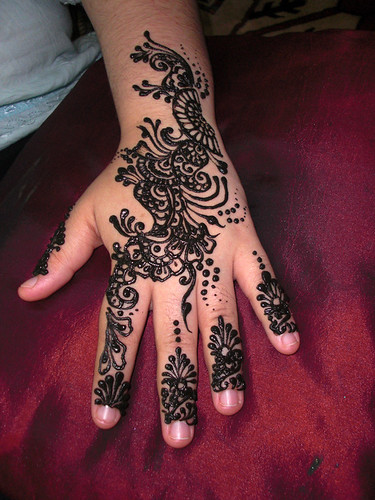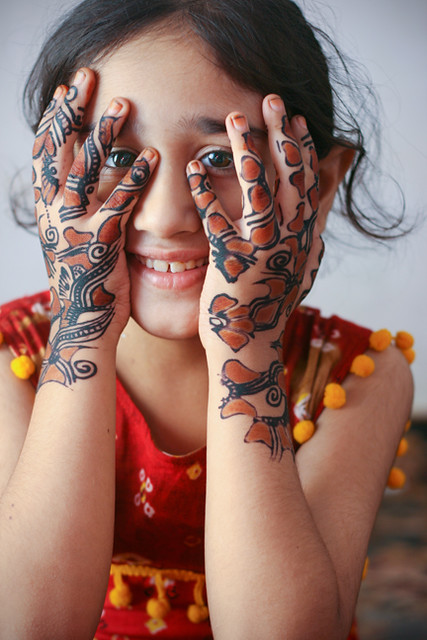Mehandi Design Arabic Biogarphy Photos Pictures Pics Images
Source(google.com.pk)
Once familiar only within certain ethnic enclaves, the art of henna painting, also known as mendhi, has become fashionable worldwide and for good reason. Besides its beauty, henna is safe, temporary and painless. The dye, which is permanent on fabric or wood, lingers anywhere from 2-12 weeks on skin, depending upon the quality of the henna, its reaction with an individual's skin and the care taken to preserve the design. Henna is painted upon the skin; there are no needles, cutting of the flesh or insertion of dyes within the flesh. Furthermore, during the thousands of years that henna has been an art form, it has simultaneously been used for medicinal healing purposes. Henna is believed to improve the texture of hair and skin. On a spiritual level, henna is believed to bestow happiness, good fortune and all the benevolence of the universe.
Henna's historical trail begins in ancient Egypt. Modern Egypt remains one of the main commercial suppliers of the plant, as do the parts of Sudan corresponding with ancient Nubia. Egypt's associations with henna are confirmed by its botanical nickname: Egyptian privet. The term "henna" derives from the Arabic, al khanna. There is a hieroglyph, pouquer, which is believed to indicate the henna plant. The term mendhi, used synonymously for henna, derives from the Sanskrit mehandika. Much of the modern revival of henna derives from its popularity in India and Pakistan. It is believed, however, that the plant arrived in India as a gift from Egypt and there is much debate as to when it actually arrived on the subcontinent, perhaps as late as the Mogul Empire.
The earliest historical documentation of henna are the traces found upon the nails of mummified pharaohs. It is fairly certain based upon that evidence and existing images that henna was used to color the nails and to condition them: a royal manicure, if you will. There is some speculation that henna was also used, then as now, to create designs upon the body but because of henna's temporary nature, that theory may be impossible to prove. There is evidence that it was used in that fashion by Asian worshippers of the Semitic goddess Anat, one of the few foreign deities to achieve popularity in ancient Egypt, so it's fairly safe to speculate that the Egyptians were at least familiar with all henna's potential uses.
Henna's historical trail begins in ancient Egypt. Modern Egypt remains one of the main commercial suppliers of the plant, as do the parts of Sudan corresponding with ancient Nubia. Egypt's associations with henna are confirmed by its botanical nickname: Egyptian privet. The term "henna" derives from the Arabic, al khanna. There is a hieroglyph, pouquer, which is believed to indicate the henna plant. The term mendhi, used synonymously for henna, derives from the Sanskrit mehandika. Much of the modern revival of henna derives from its popularity in India and Pakistan. It is believed, however, that the plant arrived in India as a gift from Egypt and there is much debate as to when it actually arrived on the subcontinent, perhaps as late as the Mogul Empire.
The earliest historical documentation of henna are the traces found upon the nails of mummified pharaohs. It is fairly certain based upon that evidence and existing images that henna was used to color the nails and to condition them: a royal manicure, if you will. There is some speculation that henna was also used, then as now, to create designs upon the body but because of henna's temporary nature, that theory may be impossible to prove. There is evidence that it was used in that fashion by Asian worshippers of the Semitic goddess Anat, one of the few foreign deities to achieve popularity in ancient Egypt, so it's fairly safe to speculate that the Egyptians were at least familiar with all henna's potential uses.
Mehandi Design Arabic Photos Pictures Pics Images
Mehandi Design Arabic Photos Pictures Pics Images
Mehandi Design Arabic Photos Pictures Pics Images
Mehandi Design Arabic Photos Pictures Pics Images
Mehandi Design Arabic Photos Pictures Pics Images
Mehandi Design Arabic Photos Pictures Pics Images
Mehandi Design Arabic Photos Pictures Pics Images
Mehandi Design Arabic Photos Pictures Pics Images








No comments:
Post a Comment